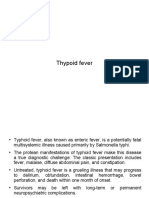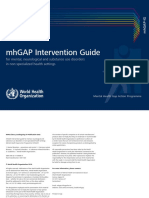Salmonella Infections
Salmonella Infections
Uploaded by
Yolanda Dwi OktaviyaniCopyright:
Available Formats
Salmonella Infections
Salmonella Infections
Uploaded by
Yolanda Dwi OktaviyaniOriginal Description:
Copyright
Available Formats
Share this document
Did you find this document useful?
Is this content inappropriate?
Copyright:
Available Formats
Salmonella Infections
Salmonella Infections
Uploaded by
Yolanda Dwi OktaviyaniCopyright:
Available Formats
-
Salmonella Infections
Complications
Extra-intestinal
infectious complications
recognition
of these can prevent a delay in diagnosis
can
occur
and
Intestinal
The two most serious complications of enteric fever are intestinal
haemorrhage and perforation, which usually occur when the
sloughs overlying the Peyers patches separate during the late
second or early third week of the illness.
Haemorrhage
Clinical signs of haemorrhage are :
- a sharp fall in body temperature and blood pressure,
- and sudden tachycardia.
- The blood passed per rectum is usually bright red but may
be altered if intestinal stasis is present. Sometimes there
may not be any passage of blood when frank ileus is
present.
Management of haemorrhage is conservative, with sedation and
transfusion unless there is evidence of perforation, when surgery
is indicated.
Perforation
Clinical sign :
- Unlike other causes of intestinal perforation, typhoid
perforation occurs in a patient who already had a vaguely
tender distended abdomen with scanty bowel sounds.
Therefore, recognition of perforation can be diffi cult.
- Usually, pain and tenderness worsen, the pulse rises and
the temperature falls suddenly.
Abdominal rigidity may not be a prominent sign and bowel
sounds may not disappear altogether.
- The discovery of free fluid in the abdomen may be the only
sign of perforation.
- Demonstration of gas under the diaphragm by X-ray is a
valuable aid to diagnosis.
The treatment of choice for typhoid perforation :
- Surgical intervention. Most surgeons prefer simple closure
of perforation with drainage of the peritoneum, and reserve
small-bowel
resection
for
patients
with
multiple
perforations
- conservative management with nasogastric suction,
antibiotic therapy directed against anaerobes and
Enterobacteriaciae, and general supportive care will reduce
the mortality to 30%
- The prognosis is clearly related to the time elapsed
between perforation and surgery.
Liver, gallbladder and pancreas
Mild jaundice may occur in enteric fever and may be due to
hepatitis, cholangitis, cholecystitis or haemolysis. Biochemical
changes indicative of hepatitis are common during the acute
stage. Liver biopsy in such cases often shows cloudy swelling,
balloon degeneration with vacuolation of hepatocytes, moderate
fatty change and focal collection of mononuclear cells typhoid
nodules (Figure 52.2). Intact typhoid bacilli can be seen at these
sites. Pancreatitis has also been reported.
Cardiorespiratory
Toxic myocarditis and endocarditis occur in 15% of cases and
represent a signifcant cause of death in endemic countries. Both
occur in severely ill toxaemic patients and is characterized by
tachycardia, weak pulse and heart sounds, hypotension and
electrocardiographic abnormalities. Respiratory symptoms, such
as cough and mild bronchitis, occur in 1186% of cases and
bronchopneumoniaor lobar consolidation may develop rarely.
Nervous system
A toxic confusional state, characterized by disorientation, delirium
and restlessness, is characteristic of late-stage typhoid but
occasionally these and other neurpsychiatric features may
dominate the clinical picture from an early stage. Facial twitching
or convulsion(s) may be the presenting feature; sometimes,
paranoid psychosis or catatonia may develop during
convalescence.
Meningism is not uncommon but bacterial meningitis caused by
S. Typhi is a rare, but recognized, complication. Encephalomyelitis
may develop and the underlying pathology may be that of
demyelinating leukoencephalopathy.Rarely, transverse myelitis,
polyneuropathy or cranial mononeuropathy may develop.
Haematological and renal
Subclinical disseminated intravascular coagulation occurs
commonly in typhoid fever; this rarely manifests as haemolytic
uraemic syndrome. Haemolysis may also be associated with
glucose 6-phosphate dehydrogenase (G6PD) defi ciency. Immune
complex glomerulitis has been reported and IgM immunoglobulin,
C3 and S. Typhi antigen can be demonstrated in the glomerular
capillary wall. Nephrotic syndrome may complicate chronic S.
Typhi bacteraemia associated with urinary schistosomiasis.
Musculoskeletal and other systems
Skeletal muscle characteristically shows Zenkers degeneration (a
hyaline degeneration of muscle fi bres), particularly affecting the
abdominal wall and thigh muscles; clinically evident polymyositis
may occur.
Localization may occur in almost any organ/system, and
involvement of bones, joints, meninges, endocardium, spleen and
ovary have all been reported, but such cases are rare.
Diagnosis
The definitive diagnosis of enteric fever requires the isolation of S.
Typhi or S. Paratyphi from blood, bone marrow, other sterile sites,
rose spots, stool, or intestinal secretions.. Isolation from stool or
urine provides strong presumptive evidence only in the presence
of a characteristic clinical picture.
Blood and bone marrow culture
The defi nitive diagnosis of typhoid is by the isolation of the
organism from a sterile site. Isolation of the organism from the
stool is useful information but may be a false positive due to
longterm carriage. Thus, in patients with suspected typhoid, blood
or bone marrow cultures should be performed. Modern automated
systems rapidly detect the presence of the organism, but
conventional non-automated methods also have a high diagnostic
yield
Faecal and urine cultures
With modern techniques, faecal cultures are often positive even
during the first week, though the percentage positivity rises
steadily thereafter. Urine cultures are positive less often.
Serology
The traditional Widal test measures antibodies against flagellar
(H) and somatic (O) antigens of the causative organism. In acute
infection, O antibody appears first, rising progressively, later
falling and often disappearing within a few months. H antibody
appears a little later but persists for longer. Rising or high O
antibody titre generally indicates acute infection, whereas raised
H antibody helps to identify the type of enteric fever.
However, the Widal test has many limitations :
Raised antibodies may have resulted from previous typhoid
immunization or earlier infection(s) with salmonellae
sharing common O antigens with S. Typhi or S. Paratyphi.
- In endemic countries, patients have higher H antibody
titres. This is a particular problem in developing countries,
where background antibodies mean that the Widal test
lacks sensitivity.
- Some patients show a poor or negligible antibody response
to active infection.
Vi antibody is often raised during acute infection and persists
afterwards during chronic carriage. However, its use as a
screening test for the carrier state is limited because of the
frequency of false positives and false negatives
Newer Diagnostic Methods
Newer tests that directly detect IgM or IgG antibodies to a wide
range of specific S. typhi antigens have been developed, such as
Typhidot and Tubex. Some of these tests have been adapted to a
simple dipstick technique using whole bacteria antigens to detect
IgM antibody and may be of benefit in situations where a
laboratory is not available. While they compare favourably with
the Widal test, none of them performs as well as blood culture.
Furthermore, antimicrobial susceptibility testing cannot be
performed, nor can molecular epidemiological work. Their use
should currently be confined to outbreak situations, where pretest
probability of typhoid is high. Urinary Vi antigen ELISAs and PCRbased assays are under development,but have not yet reached
the point where they are ready for deployment as rapiddiagnostic tests.
Reference :
- Mansons Tropical Disease 23
- Harrisons Internal Medicine
You might also like
- Megger Test Report FormDocument1 pageMegger Test Report Formkokocdf67% (6)
- John Deere Xuv 825i s4 Gator Utility Vehicle Operators ManualDocument108 pagesJohn Deere Xuv 825i s4 Gator Utility Vehicle Operators ManualLloyd Harvey100% (1)
- 2020 Midyear Little Jellycat CatalogDocument88 pages2020 Midyear Little Jellycat CatalogJayNo ratings yet
- CMS Int. Med1 AnswersDocument15 pagesCMS Int. Med1 AnswersDiego Al Gutierrez50% (2)
- Operating Manual Infusomat Space PDFDocument82 pagesOperating Manual Infusomat Space PDFamirali.bme4527No ratings yet
- Fever of Unknown OriginDocument36 pagesFever of Unknown OriginAbdo OufNo ratings yet
- Fever With Jaundice and A Purpuric RashDocument4 pagesFever With Jaundice and A Purpuric RashRaida Uceda GarniqueNo ratings yet
- Pemicu 3Document15 pagesPemicu 3iche_lovemeNo ratings yet
- Typhoid FeverDocument15 pagesTyphoid Fevermonicamashinkila1234No ratings yet
- Acute GlomerulonephritisDocument4 pagesAcute GlomerulonephritisJulliza Joy PandiNo ratings yet
- Anak 1Document4 pagesAnak 1Vega HapsariNo ratings yet
- Leptospirosis DifferentialDocument4 pagesLeptospirosis DifferentialPatrick DeeNo ratings yet
- Henoch - Schonlein Purpura (HSP) : - It Is The Most Common Cause of Non-Thrombocytopenic Purpura in ChildrenDocument23 pagesHenoch - Schonlein Purpura (HSP) : - It Is The Most Common Cause of Non-Thrombocytopenic Purpura in ChildrenLaith DmourNo ratings yet
- 8.3 Medicine - Tropical Infectious Diseases Leptospirosis 2014ADocument7 pages8.3 Medicine - Tropical Infectious Diseases Leptospirosis 2014ABhi-An BatobalonosNo ratings yet
- Fever of Unknown OriginDocument8 pagesFever of Unknown OriginReyhan HadimanNo ratings yet
- Signs and Symptoms : Feces SerovarDocument2 pagesSigns and Symptoms : Feces SerovarpjpropraveenssNo ratings yet
- What Is Acute Glomerulonephritis?: Acute Glomerulonephritis (GN) Comprises A Specific Set of Renal Diseases inDocument6 pagesWhat Is Acute Glomerulonephritis?: Acute Glomerulonephritis (GN) Comprises A Specific Set of Renal Diseases inAnnapoorna SHNo ratings yet
- Typhoid Fever (Enteric Fever)Document63 pagesTyphoid Fever (Enteric Fever)tomb87005No ratings yet
- Clinical Practice Guidelines of Leptospirosis (2010)Document18 pagesClinical Practice Guidelines of Leptospirosis (2010)Kenneth MiguelNo ratings yet
- DengueDocument36 pagesDengueMohd Alfian Awang Ku LekNo ratings yet
- Pyrexia of Unknown OriginDocument81 pagesPyrexia of Unknown OriginJithin Bhagavati Kalam100% (1)
- Typhoid Fever: Dr. Dur Muhammad Khan (Mrcp. FRCP)Document52 pagesTyphoid Fever: Dr. Dur Muhammad Khan (Mrcp. FRCP)Osama HassanNo ratings yet
- INFECTIONS Dengue Fever and Dengue Hemorrhagic FeverDocument36 pagesINFECTIONS Dengue Fever and Dengue Hemorrhagic FeverDr.P.NatarajanNo ratings yet
- Thypoid FeverDocument6 pagesThypoid FeverRizki DickyNo ratings yet
- Causes of Drowsiness in This PatientDocument12 pagesCauses of Drowsiness in This PatientNu JoeNo ratings yet
- Leptospirosis: Interrogans, Pomona, Icterohaemorrhagiae, Canicola, and AutumnalisDocument5 pagesLeptospirosis: Interrogans, Pomona, Icterohaemorrhagiae, Canicola, and AutumnalisAlina CebanNo ratings yet
- Acute Poststreptococcal Glomerulonephritis (Apsgn) in ChildrenDocument22 pagesAcute Poststreptococcal Glomerulonephritis (Apsgn) in ChildrenOlivia PutriNo ratings yet
- Typhoid Fever 1Document33 pagesTyphoid Fever 1fortunechipoya86No ratings yet
- Infective Endocarditis.... MshembaDocument39 pagesInfective Endocarditis.... MshembaTimothy Casmiry MshembaNo ratings yet
- Septicaemia (Bacterial Sepsis) and TB Lymphadenitis: Prepared By: Dr. Zacharia J.Z. ToyiDocument29 pagesSepticaemia (Bacterial Sepsis) and TB Lymphadenitis: Prepared By: Dr. Zacharia J.Z. ToyiGideon HaburaNo ratings yet
- Acquired RHD BestDocument95 pagesAcquired RHD BestauNo ratings yet
- Infective EndocarditisDocument12 pagesInfective EndocarditisYoulin KohNo ratings yet
- Typhoid FeverDocument9 pagesTyphoid FeverValerrie NgenoNo ratings yet
- Sepsis and Septic Shock - Critical Care MedicineDocument2 pagesSepsis and Septic Shock - Critical Care MedicineMihaela MoraruNo ratings yet
- Fever of Unknown Origin (FUO)Document55 pagesFever of Unknown Origin (FUO)mohamed hanyNo ratings yet
- Staphylococcal Toxic Shock Syndrome: M Kare, A DangDocument3 pagesStaphylococcal Toxic Shock Syndrome: M Kare, A DangAnonymous ALlIo2LNo ratings yet
- Case 1Document4 pagesCase 1Irsanti SasmitaNo ratings yet
- Infections of Gastrointestinal TractDocument35 pagesInfections of Gastrointestinal Tract180045No ratings yet
- Geriatric Confusion CaseDocument8 pagesGeriatric Confusion CaseStarr NewmanNo ratings yet
- Typhoid FeverDocument46 pagesTyphoid Feverdeskichinta50% (2)
- TyphoidDocument13 pagesTyphoidMayuri VohraNo ratings yet
- S Infective EndocarditisDocument24 pagesS Infective EndocarditisMpanso Ahmad AlhijjNo ratings yet
- Leptospirosis: Diagnosis & TreatmentDocument20 pagesLeptospirosis: Diagnosis & TreatmentMuhammed SalahNo ratings yet
- P 2 InfectiousDocument54 pagesP 2 InfectiousHIMANSHU GUPTANo ratings yet
- Rheumatic Endocarditis: o o o o oDocument5 pagesRheumatic Endocarditis: o o o o ogaratoh099No ratings yet
- 4th Grand CPC ScriptDocument3 pages4th Grand CPC ScriptEunice RiveraNo ratings yet
- DengueDocument13 pagesDengueHarshini ChandraboseNo ratings yet
- Thyphoid FeverDocument66 pagesThyphoid FeverPurnamandala Abu FarisNo ratings yet
- Agn & Uti Pearls - YomDocument39 pagesAgn & Uti Pearls - YomEbaNo ratings yet
- Pediatric Fungal EndocarditisDocument9 pagesPediatric Fungal EndocarditisGuntur Marganing Adi NugrohoNo ratings yet
- Acute Febrile IllnessesDocument54 pagesAcute Febrile IllnessesfraolNo ratings yet
- Joel Vasanth PeterDocument38 pagesJoel Vasanth PeterJoelPeterNo ratings yet
- Case 06Document5 pagesCase 06Chefera AgaNo ratings yet
- Enteric Fever: Typhoid TyphoidDocument2 pagesEnteric Fever: Typhoid TyphoidAjay Pal NattNo ratings yet
- Leptospirosis - Policy Guide by PhilhealthDocument6 pagesLeptospirosis - Policy Guide by PhilhealthKathrina AbastarNo ratings yet
- Crux 05Document8 pagesCrux 05Rajkishor YadavNo ratings yet
- Leptospirosis: Where Is Leptospirosis Found?Document4 pagesLeptospirosis: Where Is Leptospirosis Found?Ariffe Ad-dinNo ratings yet
- Enteric VikrannthDocument71 pagesEnteric Vikrannthvikrannth vNo ratings yet
- Am Fam Physician. 1998 Aug 1 58 (2) :405-408.: Clinical Presentation RashDocument6 pagesAm Fam Physician. 1998 Aug 1 58 (2) :405-408.: Clinical Presentation RashAnastasia Widha SylvianiNo ratings yet
- A Case of Typhoid Fever Presenting With Multiple ComplicationsDocument4 pagesA Case of Typhoid Fever Presenting With Multiple ComplicationsCleo CaminadeNo ratings yet
- Heart Valve Disease: State of the ArtFrom EverandHeart Valve Disease: State of the ArtJose ZamoranoNo ratings yet
- Alert Medical Series: USMLE Alert I, II, IIIFrom EverandAlert Medical Series: USMLE Alert I, II, IIIRating: 2 out of 5 stars2/5 (1)
- 0616 SCuDocument18 pages0616 SCuYolanda Dwi OktaviyaniNo ratings yet
- WHO MHGap Guide English PDFDocument121 pagesWHO MHGap Guide English PDFYolanda Dwi OktaviyaniNo ratings yet
- Dash BriefDocument6 pagesDash BriefYolanda Dwi Oktaviyani100% (1)
- LI Famed HypertensionDocument3 pagesLI Famed HypertensionYolanda Dwi OktaviyaniNo ratings yet
- Prenatal CareDocument3 pagesPrenatal CareYolanda Dwi OktaviyaniNo ratings yet
- Primary Headache Secondary HeadacheDocument5 pagesPrimary Headache Secondary HeadacheYolanda Dwi OktaviyaniNo ratings yet
- Attention Deficit/Hyperactivity DisorderDocument3 pagesAttention Deficit/Hyperactivity DisorderYolanda Dwi OktaviyaniNo ratings yet
- Malariae, and P Ovale. The Two Most Common Species Are P Vivax and P Falciparum, WithDocument3 pagesMalariae, and P Ovale. The Two Most Common Species Are P Vivax and P Falciparum, WithYolanda Dwi OktaviyaniNo ratings yet
- Plasmodium LIDocument2 pagesPlasmodium LIYolanda Dwi OktaviyaniNo ratings yet
- Stem Cell: 3.1. DefinitionDocument4 pagesStem Cell: 3.1. DefinitionYolanda Dwi OktaviyaniNo ratings yet
- On-Board Computer IV: Training Reference BookDocument12 pagesOn-Board Computer IV: Training Reference BookMadis MooraNo ratings yet
- Determination of Heat of Combustion of Biodiesel Using Bomb CalorimeterDocument3 pagesDetermination of Heat of Combustion of Biodiesel Using Bomb CalorimeterIsmail RahimNo ratings yet
- EMTL Question PaperDocument2 pagesEMTL Question PaperJayaram KrishnaNo ratings yet
- Good Hope School 16 21 3B Ch.8 Coordinate Geometry of Straight Lines CQDocument4 pagesGood Hope School 16 21 3B Ch.8 Coordinate Geometry of Straight Lines CQcharliedbsNo ratings yet
- Sist en Iso 7346 2 1998Document9 pagesSist en Iso 7346 2 1998Dave ManimbenNo ratings yet
- Microwave BenchDocument92 pagesMicrowave BenchharshadasawantNo ratings yet
- TrerwtDocument154 pagesTrerwtvinicius gomes duarteNo ratings yet
- Technical Manual For Single-Family Kit Art. KAE5061Document12 pagesTechnical Manual For Single-Family Kit Art. KAE5061DjoNo ratings yet
- Hybridization 1Document36 pagesHybridization 1Yordanos GetnetNo ratings yet
- Non AntimicrobialsDocument88 pagesNon AntimicrobialsArvenaa SubramaniamNo ratings yet
- Shwe Yee Win: Personal DataDocument3 pagesShwe Yee Win: Personal DataPyae PhyoeNo ratings yet
- Especificaciones Motores de ArranqueDocument19 pagesEspecificaciones Motores de ArranqueVictor LuqueNo ratings yet
- Prawn B.Sc-I Semester IDocument15 pagesPrawn B.Sc-I Semester ICentral DogmaNo ratings yet
- MCQ For Magnetic Effects of Electric CurrentDocument6 pagesMCQ For Magnetic Effects of Electric CurrentramamohanNo ratings yet
- LP Chemical ReactionDocument5 pagesLP Chemical ReactionAries Blado Pascua0% (1)
- ASCE 7-10SnowLoadProvisionsJuly2012Document49 pagesASCE 7-10SnowLoadProvisionsJuly2012Mike Junior0% (1)
- Vitapex. A Case Report PDFDocument4 pagesVitapex. A Case Report PDFPamela GuzmánNo ratings yet
- Badminton England Risk Assessment: Hazard Consequence Control MeasuresDocument2 pagesBadminton England Risk Assessment: Hazard Consequence Control MeasuresdanielNo ratings yet
- Question Bank: Unit-1Document10 pagesQuestion Bank: Unit-1044Devanshi SutariyaNo ratings yet
- Unit-5: The Link Layer and Local Area NetworksDocument38 pagesUnit-5: The Link Layer and Local Area NetworksJinkal DarjiNo ratings yet
- Articles and NounsDocument6 pagesArticles and NounsRoman FuentesNo ratings yet
- Assignment - Vectors - Session-1 - AnswerDocument4 pagesAssignment - Vectors - Session-1 - AnsweraadityaNo ratings yet
- Magnetism-Electromagnetism Notes - STUDENT PDFDocument9 pagesMagnetism-Electromagnetism Notes - STUDENT PDFHabiba UstoNo ratings yet
- Government Engineering College Jhalawar: Gram Chandloi, Sunel Road, Tehsil Jhalrapatan, Jhalawar (Raj.) 326023Document5 pagesGovernment Engineering College Jhalawar: Gram Chandloi, Sunel Road, Tehsil Jhalrapatan, Jhalawar (Raj.) 326023Nikhil SinghNo ratings yet
- rr1145 Soft Landing Systems Working at HeightDocument44 pagesrr1145 Soft Landing Systems Working at HeightChris ParkinsonNo ratings yet
- Ganga Basin: Presented By: Barsha Rani Das Roll. No: PE 04/16 Petroleum Engineering, 6 SemesterDocument20 pagesGanga Basin: Presented By: Barsha Rani Das Roll. No: PE 04/16 Petroleum Engineering, 6 SemesterAbu ikhtiarNo ratings yet



































































































